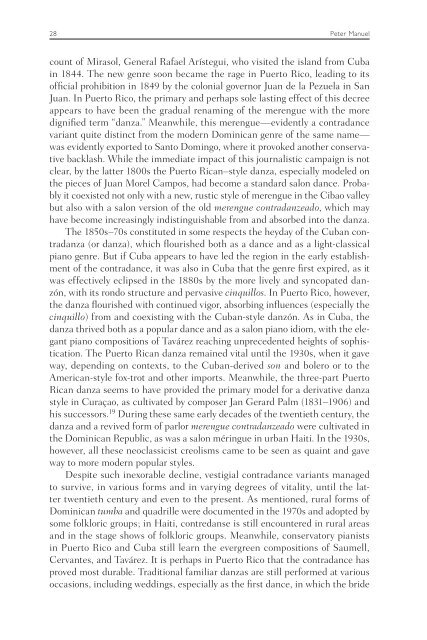Creolizing Contradance in the Caribbean - Temple University
Creolizing Contradance in the Caribbean - Temple University
Creolizing Contradance in the Caribbean - Temple University
Create successful ePaper yourself
Turn your PDF publications into a flip-book with our unique Google optimized e-Paper software.
28 Peter Manuel<br />
count of Mirasol, General Rafael Arístegui, who visited <strong>the</strong> island from Cuba<br />
<strong>in</strong> 1844. The new genre soon became <strong>the</strong> rage <strong>in</strong> Puerto Rico, lead<strong>in</strong>g to its<br />
official prohibition <strong>in</strong> 1849 by <strong>the</strong> colonial governor Juan de la Pezuela <strong>in</strong> San<br />
Juan. In Puerto Rico, <strong>the</strong> primary and perhaps sole last<strong>in</strong>g effect of this decree<br />
appears to have been <strong>the</strong> gradual renam<strong>in</strong>g of <strong>the</strong> merengue with <strong>the</strong> more<br />
dignified term “danza.” Meanwhile, this merengue—evidently a contradance<br />
variant quite dist<strong>in</strong>ct from <strong>the</strong> modern Dom<strong>in</strong>ican genre of <strong>the</strong> same name—<br />
was evidently exported to Santo Dom<strong>in</strong>go, where it provoked ano<strong>the</strong>r conservative<br />
backlash. While <strong>the</strong> immediate impact of this journalistic campaign is not<br />
clear, by <strong>the</strong> latter 1800s <strong>the</strong> Puerto Rican–style danza, especially modeled on<br />
<strong>the</strong> pieces of Juan Morel Campos, had become a standard salon dance. Probably<br />
it coexisted not only with a new, rustic style of merengue <strong>in</strong> <strong>the</strong> Cibao valley<br />
but also with a salon version of <strong>the</strong> old merengue contradanzeado, which may<br />
have become <strong>in</strong>creas<strong>in</strong>gly <strong>in</strong>dist<strong>in</strong>guishable from and absorbed <strong>in</strong>to <strong>the</strong> danza.<br />
The 1850s–70s constituted <strong>in</strong> some respects <strong>the</strong> heyday of <strong>the</strong> Cuban contradanza<br />
(or danza), which flourished both as a dance and as a light-classical<br />
piano genre. But if Cuba appears to have led <strong>the</strong> region <strong>in</strong> <strong>the</strong> early establishment<br />
of <strong>the</strong> contradance, it was also <strong>in</strong> Cuba that <strong>the</strong> genre first expired, as it<br />
was effectively eclipsed <strong>in</strong> <strong>the</strong> 1880s by <strong>the</strong> more lively and syncopated danzón,<br />
with its rondo structure and pervasive c<strong>in</strong>quillos. In Puerto Rico, however,<br />
<strong>the</strong> danza flourished with cont<strong>in</strong>ued vigor, absorb<strong>in</strong>g <strong>in</strong>fluences (especially <strong>the</strong><br />
c<strong>in</strong>quillo) from and coexist<strong>in</strong>g with <strong>the</strong> Cuban-style danzón. As <strong>in</strong> Cuba, <strong>the</strong><br />
danza thrived both as a popular dance and as a salon piano idiom, with <strong>the</strong> elegant<br />
piano compositions of Tavárez reach<strong>in</strong>g unprecedented heights of sophistication.<br />
The Puerto Rican danza rema<strong>in</strong>ed vital until <strong>the</strong> 1930s, when it gave<br />
way, depend<strong>in</strong>g on contexts, to <strong>the</strong> Cuban-derived son and bolero or to <strong>the</strong><br />
American-style fox-trot and o<strong>the</strong>r imports. Meanwhile, <strong>the</strong> three-part Puerto<br />
Rican danza seems to have provided <strong>the</strong> primary model for a derivative danza<br />
style <strong>in</strong> Curaçao, as cultivated by composer Jan Gerard Palm (1831–1906) and<br />
his successors. 19 Dur<strong>in</strong>g <strong>the</strong>se same early decades of <strong>the</strong> twentieth century, <strong>the</strong><br />
danza and a revived form of parlor merengue contradanzeado were cultivated <strong>in</strong><br />
<strong>the</strong> Dom<strong>in</strong>ican Republic, as was a salon mér<strong>in</strong>gue <strong>in</strong> urban Haiti. In <strong>the</strong> 1930s,<br />
however, all <strong>the</strong>se neoclassicist creolisms came to be seen as qua<strong>in</strong>t and gave<br />
way to more modern popular styles.<br />
Despite such <strong>in</strong>exorable decl<strong>in</strong>e, vestigial contradance variants managed<br />
to survive, <strong>in</strong> various forms and <strong>in</strong> vary<strong>in</strong>g degrees of vitality, until <strong>the</strong> latter<br />
twentieth century and even to <strong>the</strong> present. As mentioned, rural forms of<br />
Dom<strong>in</strong>ican tumba and quadrille were documented <strong>in</strong> <strong>the</strong> 1970s and adopted by<br />
some folkloric groups; <strong>in</strong> Haiti, contredanse is still encountered <strong>in</strong> rural areas<br />
and <strong>in</strong> <strong>the</strong> stage shows of folkloric groups. Meanwhile, conservatory pianists<br />
<strong>in</strong> Puerto Rico and Cuba still learn <strong>the</strong> evergreen compositions of Saumell,<br />
Cervantes, and Tavárez. It is perhaps <strong>in</strong> Puerto Rico that <strong>the</strong> contradance has<br />
proved most durable. Traditional familiar danzas are still performed at various<br />
occasions, <strong>in</strong>clud<strong>in</strong>g wedd<strong>in</strong>gs, especially as <strong>the</strong> first dance, <strong>in</strong> which <strong>the</strong> bride
















